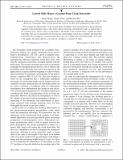Lateral Shift Makes a Ground-Plane Cloak Detectable
Author(s)
Zhang, Baile; Chan, Tucker R.; Wu, Bae-Ian
DownloadZhang-2010-Lateral Shift Makes.pdf (538.9Kb)
PUBLISHER_POLICY
Publisher Policy
Article is made available in accordance with the publisher's policy and may be subject to US copyright law. Please refer to the publisher's site for terms of use.
Terms of use
Metadata
Show full item recordAbstract
We examine the effectiveness of the ground-plane invisibility cloak generated from quasiconformal mapping of electromagnetic space. This cloak without anisotropy will generally lead to a lateral shift of the scattered wave, whose value is comparable to the height of the cloaked object, making the object detectable. This can be explained by the fact that the corresponding virtual space is thinner and wider than it should be. Ray tracing on a concrete model shows that, for a bump with a maximum height of 0.2 units to be hidden, the lateral shift of a ray with 45° incidence is around 0.15 units.
Date issued
2010-06Department
Massachusetts Institute of Technology. Department of Physics; Massachusetts Institute of Technology. Research Laboratory of ElectronicsJournal
Physical Review Letters
Publisher
American Physical Society
Citation
Zhang, Baile, Tucker Chan and Bae-lan Wu. "Lateral Shift Makes a Ground-Plane Cloak Detectable." Physical Review Letters 104.23 (2010): 233903. © 2010 The American Physical Society
Version: Final published version
ISSN
0031-9007